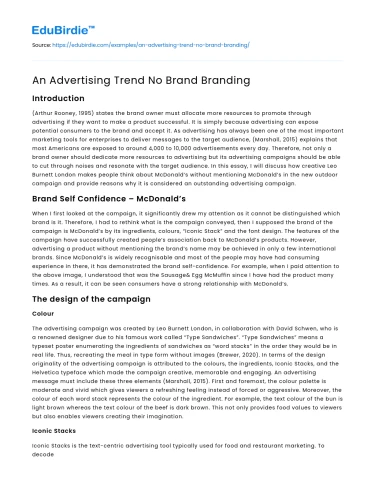Introduction
(Arthur Rooney, 1995) states the brand owner must allocate more resources to promote through advertising if they want to make a product successful. It is simply because advertising can expose potential consumers to the brand and accept it. As advertising has always been one of the most important marketing tools for enterprises to deliver messages to the target audience, (Marshall, 2015) explains that most Americans are exposed to around 4,000 to 10,000 advertisements every day. Therefore, not only a brand owner should dedicate more resources to advertising but its advertising campaigns should be able to cut through noises and resonate with the target audience. In this essay, I will discuss how creative Leo Burnett London makes people think about McDonald’s without mentioning McDonald’s in the new outdoor campaign and provide reasons why it is considered an outstanding advertising campaign.
Brand Self Confidence – McDonald’s
When I first looked at the campaign, it significantly drew my attention as it cannot be distinguished which brand is it. Therefore, I had to rethink what is the campaign conveyed, then I supposed the brand of the campaign is McDonald’s by its ingredients, colours, “Iconic Stack” and the font design. The features of the campaign have successfully created people’s association back to McDonald’s products. However, advertising a product without mentioning the brand’s name may be achieved in only a few international brands. Since McDonald’s is widely recognisable and most of the people may have had consuming experience in there, it has demonstrated the brand self-confidence. For example, when I paid attention to the above image, I understood that was the Sausage& Egg McMuffin since I have had the product many times. As a result, it can be seen consumers have a strong relationship with McDonald’s.
Save your time!
We can take care of your essay
- Proper editing and formatting
- Free revision, title page, and bibliography
- Flexible prices and money-back guarantee
The design of the campaign
Colour
The advertising campaign was created by Leo Burnett London, in collaboration with David Schwen, who is a renowned designer due to his famous work called “Type Sandwiches”. “Type Sandwiches” means a typeset poster enumerating the ingredients of sandwiches as “word stacks” in the order they would be in real life. Thus, recreating the meal in type form without images (Brewer, 2020). In terms of the design originality of the advertising campaign is attributed to the colours, the ingredients, Iconic Stacks, and the Helvetica typeface which made the campaign creative, memorable and engaging. An advertising message must include these three elements (Marshall, 2015). First and foremost, the colour palette is moderate and vivid which gives viewers a refreshing feeling instead of forced or aggressive. Moreover, the colour of each word stack represents the colour of the ingredient. For example, the text colour of the bun is light brown whereas the text colour of the beef is dark brown. This not only provides food values to viewers but also enables viewers creating their imagination.
Iconic Stacks
Iconic Stacks is the text-centric advertising tool typically used for food and restaurant marketing. To decode the text of food ingredients into consumers’ mind, it will make consumers salivate. It is how McDonald’s build a relationship with the target audience. From my perspective, it is similar to a menu in an Italian restaurant as I often read the description of the dish before what to order.
Helvetica typeface
The campaign adopted the Helvetica font because it is one of the most common and popular typefaces in the world. Due to its minimalist concept, It has been largely used in many brands and social media platforms, such as Burberry, Off-white™, NASA, Knoll, and Remowa, and Facebook and Instagram’s posts (HYPEBEAST ZH, 2020). Technically speaking, Helvetica is sans-serif, which means it does not contain the small lines or end strokes so that it is not referencing any language or era. One advantage of using Helvetica font is because it gives no meaning, which can fit in a part of our culture and daily lives ('The Simplicity of Helvetica | Webdesigner Depot', 2010). Think about whether Times New Roman can achieve the same result? Another advantage of adopting Helvetica typeface is that viewers can concentrate on the text rather being distracted or bored by the font. Therefore, it is widely used in aeroplanes logos, sneakers, product logos, coins, websites, packaging, and numerous other items. Besides, versions of Helvetica are even available in Japanese, Chinese, Korean, and Greek etc. The simplicity and minimalist of Helvetica have made the McDonald’s campaign more readable and noticeable.
References
- Arthur Rooney, J. (1995). Branding: a trend for today and tomorrow. Journal Of Product & Brand Management, 4(4), 48-55. https://doi.org/10.1108/10610429510097690
- Marshall, R. (2015). How Many Ads Do You See in One Day?. Red Crow Marketing. Retrieved 19 March 2020, from https://www.redcrowmarketing.com/2015/09/10/many-ads-see-one-day/.
- Brewer, J. (2020). This McDonald’s campaign depicts its menu in typographic form. Itsnicethat.com. Retrieved 20 March 2020, from https://www.itsnicethat.com/news/leo-burnett-london-david-schwen-iconic-stacks-mcdonalds-advertising-300120.
- (2020, March 11). Helvetica 字體為何受到諸多奢侈品牌的青睞?| Behind The HYPE [Video File]. Retrieved from https://www.youtube.com/watch?v=wVkRjSXZ7mI
- The Simplicity of Helvetica | Webdesigner Depot. Webdesigner Depot. (2010). Retrieved 20 March 2020, from https://www.webdesignerdepot.com/2010/01/the-simplicity-of-helvetica/.
- Hitti, N. (2020). McDonald's latest ads sub out its brand name for ingredients lists. Dezeen. [Photograph]. Retrieved 20 March 2020, from https://www.dezeen.com/2020/02/12/mcdonalds-advertisement-leo-burnett/.






 Stuck on your essay?
Stuck on your essay?

